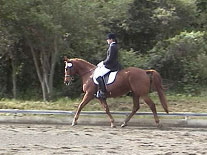By Tonja Dausend
A
brief description:
DAP,
also called diagonal dissociation, is an abbreviation
for diagonal advanced placement. While trotting, DAP
describes one foot of a diagonal pair landing a fraction
of a second before the other foot. DAP is said to be
positive (+DAP) when the hind foot in a diagonal pair
lands a fraction of a second before the front foot. DAP
is said to be negative (-DAP) when the front foot in a
diagonal pair lands a fraction of a second before the
hind foot. A horse is said to have zero DAP (0 DAP) when
the diagonal pair lands together.
   
Some
Details:
Some
consider +DAP (diagonal dissociation) to be a desirable
trait for today’s dressage competition horses. However,
there are classical masters, both past and present, who
consider +DAP to be an impurity of the gait. Even though
the actual placement of the +DAP steps themselves may be
invisible to the naked eye, other visual symptoms such
as imbalance and tension can be clearly visible. In
addition, +DAP strides are audible. The classical
masters did not need the marvels of modern technology to
recognize +DAP; they could hear it. You can hear
+DAP
interval simulations
for yourself:
http://www.ridingart/+dap_sounds.htm
The
assumption is that the hind hoof lands a fraction of a
second before the diagonal fore and that both feet then
leave the ground at the same time. But this is vary
rarely ever the case.
What is
far more frequently seen (even in the top competition
rides) is that when the hind hoof lands first the
forehand continues forward until the forehoof lands,
causing the horse to be out behind.
When watching
video of the top dressage competition horses +DAPing in
slow motion it is very often noticeable that the front
end of the horse is slowed down in relation to the hind
end. The forehand is basically a fraction of a beat
behind the hindquarters throughout the stride. There
seems to be a correlation between the amount of +DAP and
the length of time the front hoof is left on the ground
after the hind hoof has taken off. When the diagonal
pair land together they usually leave the ground
together. When the hind hoof lands well in advance of
the front hoof, the front hoof is usually grounded
relatively longer. When the hind hoof lands barely in
advance of the front hoof, the front hoof usually
ends up grounded but not as long as when the +DAP is
greater.
At
Issue:
When a horse has one front
hoof planted in the ‘trot’ and the hind hooves have
already lifted off (a prevalent phase of the +DAP
stride, even at top levels of competition!) the horse is
not through. The hind legs go straight and push the
croup upward. The haunches are not in a position to help
carry the forehand. Additionally, the croup is not
engaged so the horse is hollow behind the saddle. The
energy sends the shoulders horizontally forward/downward
instead of lifting. The forelegs then do the lifting.
See the photographs below.
When
the horse’s stifle extends before the shoulder is ready
to catch the lift, the shoulders miss the lifting wave
of energy created by the haunches (throughness), granted
if only by a fraction of a second but they still miss
the wave. Again, it becomes the front end that does all of
the work of lifting the shoulders, head and neck and not
the haunches. The horse is on the forehand.
Click here to see
more articles by Tonja Dausend.
©2005 Tonja Dausend |

![]()